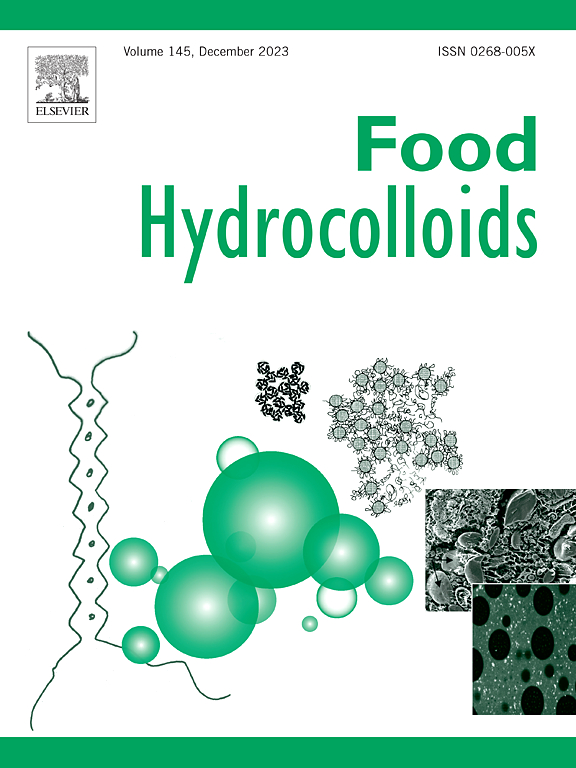Impact of the incorporation of soybean processing by-products (okara) on the physicochemical properties of carrageenan-based soybean-tofu
IF 11
1区 农林科学
Q1 CHEMISTRY, APPLIED
引用次数: 0
Abstract
Okara (solid soybean processing by-product) can improve the properties of tofu gel. However, there are few studies on the effect of okara on tofu gel in the presence of a structurally-reinforcing hydrocolloid. Therefore, this study investigated the effect of okara on the properties of κ-carrageenan-reinforced tofu. Tofu formed by two types of coagulants (glucono-δ-lactone-GDL acidification and CaCl2 electrostatic flocculation) were studied in that aspect. The water holding capacity (WHC) of GDL tofu was lowest when 30 % okara was added, while CaCl2 tofu showed a WHC maximum at 10 % okara. When 50 % okara was added, the hardness of GDL tofu and CaCl2 tofu decreased from 565 g to 409 g–182 g and 221 g, respectively. The crystallinity of GDL tofu decreased from 14.99 % to 10.91 % after adding 50 % okara. Fourier transform infrared spectroscopy indicated for okara-added tofu a stronger absorption peak at 1050 cm−1 and a shift in the amide I band, suggesting that okara affected the secondary structure of tofu proteins. Disulfide bonds and hydrogen bonds were dominant in the tofu gel, accounting for 78.04 ± 0.92 % in the tofu with 30 % okara. These results can provide theoretical guidance for the valorization of okara in tofu-type products.

大豆加工副产物的掺入对卡拉胶基豆腐乳理化性质的影响
豆渣(固体大豆加工副产品)可以改善豆腐凝胶的性能。然而,在豆腐凝胶中存在结构增强水胶体的情况下,对豆仁的影响研究很少。因此,本研究考察了卡拉胶对κ-卡拉胶增强豆腐性能的影响。研究了两种混凝剂(葡萄糖-δ-内酯- gdl酸化剂和CaCl2静电絮凝剂)对豆腐成型的影响。GDL豆腐的持水能力(WHC)在添加量为30%时最低,而CaCl2豆腐的持水能力在添加量为10%时最高。当添加50%的卡拉时,GDL豆腐和CaCl2豆腐的硬度分别从565 g下降到409 g - 182 g和221 g。加入50%的豆渣后,GDL豆腐的结晶度由14.99%下降到10.91%。傅里叶红外光谱分析表明,添加了大豆的豆腐在1050 cm−1处有更强的吸收峰,并且在酰胺I波段有移位,这表明大豆影响了豆腐蛋白质的二级结构。豆腐凝胶中以二硫键和氢键为主,占比78.04±0.92%。研究结果可为豆腐类产品中大白菜的增值提供理论指导。
本文章由计算机程序翻译,如有差异,请以英文原文为准。
求助全文
约1分钟内获得全文
求助全文
来源期刊

Food Hydrocolloids
工程技术-食品科技
CiteScore
19.90
自引率
14.00%
发文量
871
审稿时长
37 days
期刊介绍:
Food Hydrocolloids publishes original and innovative research focused on the characterization, functional properties, and applications of hydrocolloid materials used in food products. These hydrocolloids, defined as polysaccharides and proteins of commercial importance, are added to control aspects such as texture, stability, rheology, and sensory properties. The research's primary emphasis should be on the hydrocolloids themselves, with thorough descriptions of their source, nature, and physicochemical characteristics. Manuscripts are expected to clearly outline specific aims and objectives, include a fundamental discussion of research findings at the molecular level, and address the significance of the results. Studies on hydrocolloids in complex formulations should concentrate on their overall properties and mechanisms of action, while simple formulation development studies may not be considered for publication.
The main areas of interest are:
-Chemical and physicochemical characterisation
Thermal properties including glass transitions and conformational changes-
Rheological properties including viscosity, viscoelastic properties and gelation behaviour-
The influence on organoleptic properties-
Interfacial properties including stabilisation of dispersions, emulsions and foams-
Film forming properties with application to edible films and active packaging-
Encapsulation and controlled release of active compounds-
The influence on health including their role as dietary fibre-
Manipulation of hydrocolloid structure and functionality through chemical, biochemical and physical processes-
New hydrocolloids and hydrocolloid sources of commercial potential.
The Journal also publishes Review articles that provide an overview of the latest developments in topics of specific interest to researchers in this field of activity.
 求助内容:
求助内容: 应助结果提醒方式:
应助结果提醒方式:


